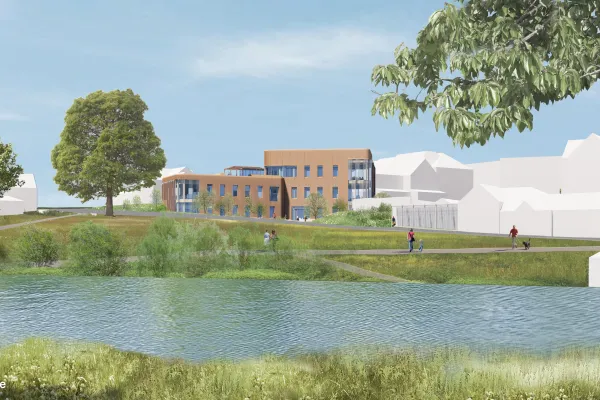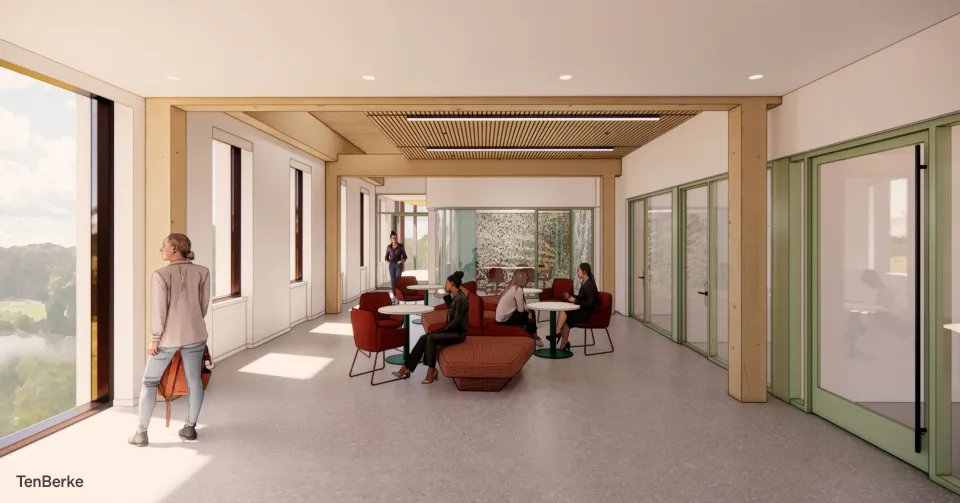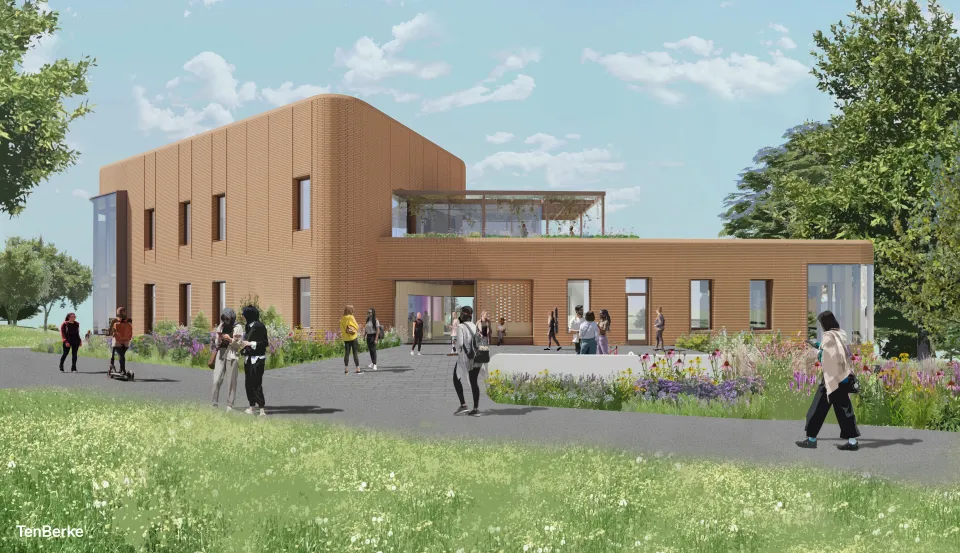Building Futures
Campus Life
Kathleen McCartney Hall will be a hub for career development and leadership

View from across Paradise Pond. Perched on a hillside, Kathleen McCartney Hall will overlook Paradise Pond at Smith College. Credit: TenBerke, press@tenberke.com Architect: TenBerke
Published November 16, 2023
Smith College prides itself on graduating leaders who, propelled by their liberal arts education and comprehensive career preparation, eagerly take on the world’s most urgent challenges. Soon, an expansive new building—being named for former Smith president Kathleen McCartney—will deepen Smith’s commitment to women’s leadership by providing an inclusive space where students can freely imagine their futures and envision how to put their education into meaningful action outside the Grécourt Gates.
“Career readiness is a response to and an amplification of the liberal arts, preparing students with the agency and agility to succeed on their own terms in an increasingly complex world,” said Smith College President Sarah Willie-LeBreton. “Kathleen McCartney Hall is being thoughtfully designed to provide students with access to resources and the skills necessary for a lifetime of changing career opportunities.”

Bright and welcoming interiors. A warm and eclectic palette and mix of soft furnishings will invite students to drop-in and linger. Credit: TenBerke, press@tenberke.com Architect: TenBerke
Here are five ways the building embodies Smith’s values of equity and sustainability, generosity, community, and innovation.
1. Sustainability as the foundation. Eschewing traditional steel and concrete, the new building—which was designed by New York-based architects TenBerke and will break ground in March 2024—will be constructed using responsibly sourced mass timber, which emits less greenhouse gas during its production and installation and makes for an eye-catching design feature. Also, a spectacular rooftop terrace, surrounded by a living roof, will provide a perfect crown to the building. When completed and connected to Smith’s forthcoming geothermal energy system, Kathleen McCartney Hall will rank among the most energy-efficient buildings on campus.
2. Purpose-driven design. At nearly 15,000 square feet, the building brings the Lazarus Center for Career Development and the Wurtele Center for Leadership together under one roof for the first time, advancing the college’s vision for providing students with the skills and qualities of mind to explore and pursue their purpose in an evolving world. Inside, students will have access to eight open work areas, as well as rooms for collaborative projects and job interviews, workshop and recruiting spaces, and even a professional-attire lending closet. With staff in nearby offices, students will have an easy time connecting directly with a team of advisers who can guide their career development journeys from day one.
3. Inspired generosity. Former Smith College trustee Margaret Wurtele ’67, who also funded the leadership center that bears her name, saw the value of a new, inclusive space for career development and provided a lead gift that ignited the project. “I am enthusiastic about programs that offer ways for students to reach beyond their academic pursuits, that encourage reflection, and that tie what they are learning in the classroom to the life they will lead after they leave Smith,” Wurtele said. “I wanted to use my naming opportunity to honor Kathleen McCartney, who helped inspire the leadership center and who was a transformational leader of Smith College.” Beth Raffeld, senior vice president for alumnae relations and development, said she hopes Wurtele’s example will inspire additional philanthropy toward a $15 million fundraising goal. “The program and the building will be a transformational program for the college and our students,” Raffeld said.

View of the entry of Kathleen McCartney Hall. Credit: TenBerke, press@tenberke.com Architect: TenBerke
4. Everyone belongs. More than 70% of first-year students at Smith report that connecting their undergraduate education to their career aspirations is a central and compelling reason for attending college. Alexandra Keller, interim dean of the college and vice president for campus life, believes the new building, with its breadth of programming and open design, will draw students in from the day they arrive on campus to the day they graduate. “New and prospective students will see so many ways to turn their academic and co-curricular experiences into the futures they are just beginning to imagine,” Keller said. Meanwhile, current students will be inspired by seeing their classmates and friends engage in programming from the Lazarus and Wurtele centers as they pass by on their way to class or to grab a coffee at the campus center. The bottom line: “The building says everyone belongs here,” Keller said.
5. An innovative approach. The vision for the new building emerged from the college’s equity imperative and is just one component of a larger effort to reimagine career preparation at Smith so that every student has access to leadership development and career education that integrates liberal arts learning with applied experiences. Already, the Lazarus Center has launched a more personal and customized model of career development that focuses on expanding students’ professional networks, iterative career planning, and real-world experiences like internships and certification programs, among other initiatives.